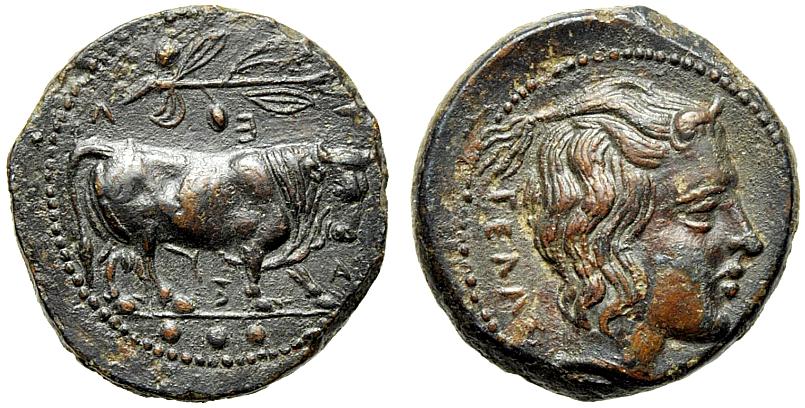AC 54d - Gela, bronze, trientes (420-405 BCE)
From SILVER
420 BCE - 405 BCE Bronze
Description
| ObverseInscription or printing placed on the obverse.: | ΓΕΛΑΣ (Greek).Bull walking r., above olive branch, in ex. three pellets |
| ReverseInscription or printing placed on the reverse.: | ΓEΛAΣ (Greek).Head of river god r. |
Mint and issuing power
| MintIdentifies the place of manufacture or issue of a numismatic object.: | Gela | Ancient regionAncient region.: | Sicily | Modern countryModern country: Italy | AuthorityIdentifies the issuing power. The authority can be "pretended" when the name or the portrait of X is on the coin but he/she was not the issuing power. It can also be "uncertain" when there is no mention of X on the coin but he/she was the issuing power according to the historical sources: |
Chronology
| FromIdentifies the initial date in a range assigned in a numismatic context. | 420 BCE | toIdentifies the final date in a range assigned in a numismatic context.. | 405 BCE | PeriodTime period of the numismatic object.: Classical 480-323 BC |
Physical description
| MetalThe physical material (usually metal) from which an object is made.: | Bronze |
Median weightMedian of the weights of numismatic objects (in grams). in grams | 4.00 | DenominationTerm indicating the value of a numismatic object. Examples: tetradrachm, chalkous, denarius.: | triens |
StandardStandard.: |
Image

AC 54d - Gela, bronze, triantes (420-405 BCE).jpg [1]
References
| Die study referencePublication of the study: | Jenkins 19701Jenkins 1970, p. 271-278, n° 495, 497-499, 501-502, 504-508, 510-511, 513, 515-516, 518-534 (groupes VIII-IX). | ||
| Coin series referenceReference to coin series study: | Sear I2Sear I, n° 1094-1095, HGC 23HGC 2, n° 379 | ||
Obverse dies distribution
no distribution is available
Reverse dies distribution
no distribution is available
Quantification
| Number of obversesNumber of obverse dies. ᵖ (o) | 150 | Number of singletons (o1)The number of singleton coins. ᵖ | |
| Number of reverse diesNumber of reverse dies. (r) | Number of coinsNumber of coins. (n) | 164 | |
| Coins per obverse dieNumber of coins per obverse die. (n/o) | 1.09 | Coins per reverse dieNumber of coins per reverse die. (n/r) | |
| Reverse per obverse ratioRatio of obverse dies divided by reverse dies. (r/o) | Percentage of singletons (o1)number of coins (n) divided by the number of singletons (o1) ᵖ | % | |
| Original number of dies (O) (Carter 1983 formula)The estimation of the number of coins according to Carter 1983 ᵖ | 1258.57 | Coins struck if 20,000 as average productivity per dieCoins made if the average productivity for obverses (according to Carter) is 20,000. ᵖ | 25,171,400 |
| Original number of dies (O) (Esty 2011 formula)The estimation of the number of coins according to the singleton formula in Esty 2011 ᵖ (O) | 1757.14 | Survival rate if 20,000 as average productivity per dieSurvival rate if average productivity is 20,000. ᵖ | 0.00001 |
| Coverage (o = % of O) (Esty 1984 formula)Esty 1984 - coverage (% of O) ᵖ (o = % of O) | % | Die productivity if survival rate 1/2,000Average productivity if survival rate is 1/2,000. ᵖ | 260.61 |
| Weight of silver (in kg) if 20,000 coins per die (O = Carter formula)Carter 1983 * Median weight * 20000 (*10 if gold or electrum) ᵖ | n.a. | Die productivity if survival rate 1/5,000Average productivity if survival rate is 1/5,000. ᵖ | 651.53 |
Remarks